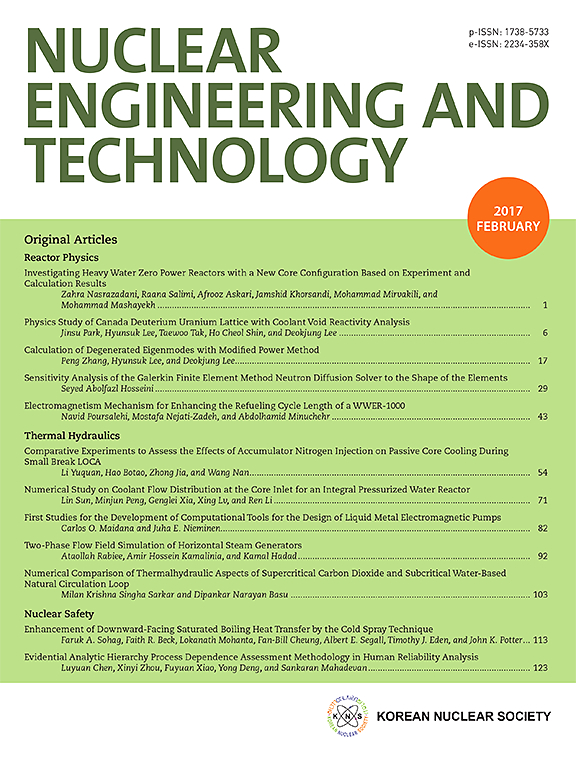通过V和Ti掺杂提高pmmn相U2Mo合金的结构稳定性和力学性能:来自密度泛函理论的见解
IF 2.6
3区 工程技术
Q1 NUCLEAR SCIENCE & TECHNOLOGY
引用次数: 0
摘要
由于先进反应堆技术对高性能核燃料的迫切需求,对铀基合金的深入研究引起了人们的极大关注。本研究采用密度泛函理论(DFT)系统研究了钒(V)和钛(Ti)掺杂对pmmn相U2Mo合金结构稳定性、电子性能、力学特性和热力学行为的影响。通过结构优化和声子谱分析,成功构建了动态稳定的掺杂构型。与原始的U4Mo2基体相比,这些掺杂体系表现出更高的热力学稳定性。态密度(DOS)分析揭示了费米能级以上V-4d轨道的强化杂化。机械方面,U4VMo表现出了实质性的改进,包括增强的剪切模量(G)和杨氏模量(E),以及沿[100]晶体方向的抗拉强度增加11%。热力学评价强调了优异的高温性能,U4MoTi在950 K时的热膨胀系数相对于基体有所增加。体积膨胀分析确定了Ti/V掺杂引起的晶格畸变弛豫,导致ΔL/L0比值升高15 - 18%。这些发现为通过过渡金属掺杂优化铀钼核燃料奠定了理论基础,为先进核燃料的设计和应用提供了重要见解。本文章由计算机程序翻译,如有差异,请以英文原文为准。
Enhancing structural stability and mechanical performance of Pmmn-phase U2Mo alloy through V and Ti Doping: Insights from density functional theory
Given the urgent demand for high-performance nuclear fuels driven by advanced reactor technologies, in-depth investigations into uranium-based alloys have garnered significant attention. This study employs density functional theory (DFT) to systematically investigate the effects of vanadium (V) and titanium (Ti) doping on the structural stability, electronic properties, mechanical characteristics, and thermodynamic behaviors of Pmmn-phase U2Mo alloys. Through structural optimization and phonon spectrum analysis, dynamically stable doped configurations were successfully constructed. These doped systems exhibit enhanced thermodynamic stability compared to the pristine U4Mo2 matrix. Density of states (DOS) analysis reveals intensified hybridization of V-4d orbitals above the Fermi level. Mechanically, U4VMo demonstrates substantial improvements, including enhanced shear modulus (G) and Young's modulus (E), along with an 11 % increase in tensile strength along the [100] crystallographic direction. Thermodynamic evaluations underscore superior high temperature performance, with U4MoTi displaying an increase in thermal expansion coefficient at 950 K relative to the matrix. Volumetric expansion analysis identifies lattice distortion relaxation induced by Ti/V doping, resulting in a 15–18 % elevation in ΔL/L0 ratios. These findings establish a theoretical foundation for optimizing uranium-molybdenum nuclear fuels through transition metal doping, offering critical insights for advanced nuclear fuel design and application.
求助全文
通过发布文献求助,成功后即可免费获取论文全文。
去求助
来源期刊

Nuclear Engineering and Technology
工程技术-核科学技术
CiteScore
4.80
自引率
7.40%
发文量
431
审稿时长
3.5 months
期刊介绍:
Nuclear Engineering and Technology (NET), an international journal of the Korean Nuclear Society (KNS), publishes peer-reviewed papers on original research, ideas and developments in all areas of the field of nuclear science and technology. NET bimonthly publishes original articles, reviews, and technical notes. The journal is listed in the Science Citation Index Expanded (SCIE) of Thomson Reuters.
NET covers all fields for peaceful utilization of nuclear energy and radiation as follows:
1) Reactor Physics
2) Thermal Hydraulics
3) Nuclear Safety
4) Nuclear I&C
5) Nuclear Physics, Fusion, and Laser Technology
6) Nuclear Fuel Cycle and Radioactive Waste Management
7) Nuclear Fuel and Reactor Materials
8) Radiation Application
9) Radiation Protection
10) Nuclear Structural Analysis and Plant Management & Maintenance
11) Nuclear Policy, Economics, and Human Resource Development
 求助内容:
求助内容: 应助结果提醒方式:
应助结果提醒方式:


